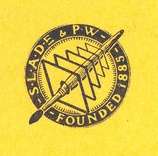Society of Lithographic Artists, Designers and Engravers
 | |
| Full name | Society of Lithographic Artists, Designers and Engravers |
|---|---|
| Founded | 1885 |
| Date dissolved | 1982 |
| Merged | National Graphical Association (1982) |
| Members | 24,921 (1980)[1] |
| Journal | SLADE Journal[1] |
| Affiliation | TUC, P&KTF, Labour |
| Office location | Slade House, Clapham Common, London[1] |
| Country | United Kingdom |
The Society of Lithographic Artists, Designers and Engravers (SLADE) was a British trade union representing workers in the printing industry.
History
The union was formed in Manchester in 1885 as the National Society of Lithographic Artists, Designers and Writers, Copperplate and Wood Engravers, and it became the Society of Lithographic Artists, Designers, Engravers and Process Workers in 1903.[2] In 1919, it relocated to London.[1]
The United Society of Engravers merged into SLADE in 1972, which promptly formed a wallpaper and textiles section. In 1975, the Slade Art Union was formed as an autonomous section of SLADE, hoping to attract workers involved in preparing photography and art.[2]
In the 1970s, there was controversy over SLADE's recruitment tactics, including the introduction of closed shops. On 12 March 1978, the Sunday Times stated: "Nearly 8000 workers have been forced mostly against their will, to join a union. Workers usually join unions to protect themselves. These workers wanted protection, but not against their bosses. They wanted protection against the very union they were being forced to join. It threatened them with the blacking of their work, the bankruptcy of their firm and the loss of their livelihoods." [3] It has been written that "the vast majority [of those 8000] felt that SLADE was ignorant of their industry, had rules and working practices inappropriate to them and considered the 'join or else your company will be put out of business' method of recruitment scandalous."[4]
The union amalgamated with the National Graphical Association (NGA) in 1982 to form the National Graphical Association (1982).
General Secretaries
References
- 1 2 3 4 Jack Eaton and Colin Gill, The Trade Union Directory (1981), pp.170-171
- 1 2 Arthur Marsh and Victoria Ryan, Historical Directory of Trade Unions, vol.1, p.200
- ↑ Quoted in 'Report of an Inquiry into Certain Trade Union Recruitment Activities', Cmnd. 7706 (1979) (Leggatt Report), page 15.
- ↑ Dunn, Stephen; Gennard, John (1984). The Closed Shop in British Industry. London and Basingstoke: Macmillan. p. 124. ISBN 0-333-26203-4.
- 1 2 3 4 5 6 7 Arthur Marsh and John B. Smethurst, Historical Directory of Trade Unions, Vol. 5, pp.17-18